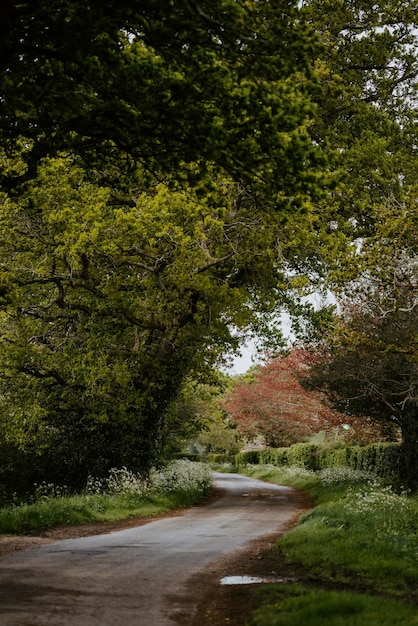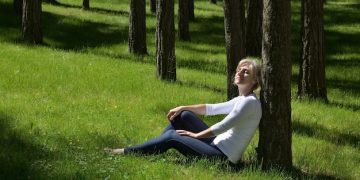Walking Meditation: Reduce Anxiety in 30 Minutes (A Step-by-Step Guide)

Walking meditation offers a simple yet powerful method to ease anxiety by combining physical movement with mindful awareness, guiding you through a focused practice to calm the mind and body effectively in just 30 minutes.
Feeling overwhelmed? Discover how walking meditation: a step-by-step guide to reducing anxiety in 30 minutes can seamlessly blend movement and mindfulness to bring calm into your daily life.
What is Walking Meditation?
Walking meditation is a form of mindfulness practice that combines the physical act of walking with focused attention. Unlike regular walking, where the goal is often to reach a destination or get exercise, the purpose of walking meditation is to become more present in the moment and cultivate a deeper awareness of your body, mind, and surroundings. It’s accessible and portable, making it an ideal way to manage anxiety throughout your day.
It’s not about achieving a specific emotional state. It’s about noticing and accepting your current state, whether it’s calm, anxious, or somewhere in between. This acceptance is a powerful tool for managing anxiety, as it allows you to observe your thoughts and feelings without judgment. By focusing on the physical sensations of walking, such as the feeling of your feet on the ground or the movement of your body, you can anchor yourself in the present moment and reduce the tendency to get caught up in anxious thoughts about the future or regrets about the past.

Key Differences from Traditional Meditation
While traditional meditation often involves sitting or assuming a stationary pose, walking meditation offers a dynamic alternative that can be particularly appealing to those who find it difficult to sit still for extended periods. This movement can make it easier to stay focused, as the physical activity provides a constant point of reference to return to when the mind wanders.
- Posture: Traditional meditation involves sitting, whereas walking meditation uses movement.
- Focus: Traditional meditation often focuses on breath, while walking meditation emphasizes the sensation of walking.
- Accessibility: Walking meditation is more accessible and can be done almost anywhere, anytime.
Walking meditation can be a powerful tool for enhancing mindfulness and reducing anxiety. Whether you’re a seasoned meditator or new to the practice, exploring this technique can offer a fresh perspective on mindfulness and introduce a new sense of calm into your daily routine.
The Benefits of Walking Meditation for Anxiety
Walking meditation offers a multitude of benefits, particularly for those struggling with anxiety. By combining physical movement with mindful awareness, this practice can help to calm the nervous system, reduce stress hormones, and promote a sense of inner peace. The rhythmic nature of walking can be incredibly soothing, allowing you to release tension and find a sense of groundedness.
The practice of walking meditation offers a unique way to integrate mindfulness into your daily routine. By tuning into the sensations of your body and your surroundings, you can cultivate a deeper sense of presence and awareness, helping you to navigate the challenges of daily life with greater ease and resilience. It’s a gentle yet effective strategy for anyone seeking to reduce anxiety and promote overall well-being.
Stress Reduction and Calming the Nervous System
Walking meditation engages the parasympathetic nervous system, which is responsible for the “rest and digest” response. This helps to counteract the effects of stress and anxiety by slowing down your heart rate, lowering blood pressure, and promoting relaxation. Regular practice can train your nervous system to be more resilient to stress, leading to a greater sense of calm and well-being.
- Reduces cortisol levels, lowering stress.
- Promotes relaxation by activating the parasympathetic nervous system.
- Enhances mood by releasing endorphins.
By gently guiding your attention back to the present moment each time your mind wanders, you strengthen your ability to focus and stay grounded. This increased focus can translate into other areas of your life, helping you to be more productive, creative, and engaged in your daily activities. It’s like training your brain to be more present and less reactive, creating a foundation for greater peace of mind.
Setting the Stage: Preparing for Your Walk
Before you begin your walking meditation, it’s important to set the stage to create a conducive environment for mindfulness. Choosing the right location, time, and attire can significantly enhance your experience and make it easier to focus on the present moment. With a little preparation, you can transform any walk into a powerful meditation session.
Consider your intentions for the meditation. Are you looking to reduce anxiety, increase self-awareness, or simply enjoy the present moment? Having a clear intention can help guide your focus and deepen your practice. Begin your walk with a relaxed and open mindset. Approach the meditation with curiosity and a willingness to observe your thoughts and feelings without judgment.

Choosing the Right Location and Time
Select a location that is relatively quiet and free from distractions. A park, garden, or even a quiet street can work well. The time of day can also impact your experience. Early morning or late afternoon are often ideal, as these times tend to be less busy and more peaceful.
- Find a quiet, safe location.
- Choose a time when you are less likely to be interrupted.
- Consider the weather and dress appropriately.
Walking meditation isn’t about reaching a destination but savoring the journey. The key is to cultivate a mindful connection with each step, allowing you to fully immerse yourself in the present moment. By focusing on the sensations of your feet making contact with the ground, you can anchor yourself in the here and now, and let go of the anxieties that may be weighing you down. Allow what is happening to happen, and accept what is not happening.
Step-by-Step Guide to Walking Meditation
Walking meditation is a simple yet profound practice that can be easily integrated into your daily routine. Whether you’re a seasoned meditator or new to mindfulness, this step-by-step guide will help you harness the power of walking to reduce anxiety and cultivate inner peace. Each step is designed to bring you deeper into the present moment, allowing you to release tension and find a sense of groundedness.
Walking with awareness is about more than just physical movement; it’s about cultivating a mental and emotional state of presence and acceptance. By focusing on the sensations of your body and your surroundings, you can quiet the chatter of your mind and find a sense of stillness within. This stillness can be incredibly powerful for managing anxiety and promoting overall well-being.
Step 1: Posture and Initial Awareness
Begin by standing tall with your feet hip-width apart. Allow your arms to hang loosely at your sides or gently clasp them in front of you. Soften your gaze and look slightly downward. Take a few deep breaths, noticing the rise and fall of your chest or abdomen. Feel your feet connecting with the ground, and bring your awareness to the present moment.
Step 2: Slow and Deliberate Steps
Initiate your walk by taking slow, deliberate steps. As you lift your foot, notice the sensation of lifting. As you move your foot forward, feel the weight shifting. As you place your foot down, notice the feeling of contact with the ground. Pay attention to the subtle movements in your body as you walk, such as the shifting of your weight, the flexing of your muscles, and the gentle sway of your arms.
Step 3: Focusing on Sensations
Direct your attention to the physical sensations of walking. Notice the feeling of your feet making contact with the ground, the movement of your legs, and the rhythm of your breath. If your mind wanders, gently guide it back to these sensations. It’s okay to get distracted—simply acknowledge the thought and return your focus to the present moment.
Step 4: Expanding Awareness
As you become more comfortable, expand your awareness to include your surroundings. Notice the sights, sounds, and smells around you. Observe the play of light and shadow, the rustling of leaves, and the scent of flowers. Allow yourself to be fully present in your environment, noticing each detail without judgment.
By bringing awareness to the details of your environment, you can cultivate a sense of connection and appreciation for the world around you. This can help to shift your perspective and reduce the intensity of anxious thoughts. It’s a way of expanding your focus beyond yourself and finding a sense of peace and wonder in the present moment.
Dealing with Distractions and Wandering Thoughts
One of the biggest challenges in meditation, including walking meditation, is dealing with distractions and wandering thoughts. It’s natural for your mind to wander, especially when you’re trying to focus on a single point of reference. The key is not to get frustrated or discouraged, but to develop strategies for gently redirecting your attention back to the present moment.
The ability to gently redirect your attention is a skill that can be developed with practice. Each time you notice your mind wandering and bring it back to the present moment, you’re strengthening your ability to focus and stay grounded. This skill can be invaluable in managing anxiety and promoting overall well-being.
Strategies for Staying Focused
When you notice your mind wandering, gently acknowledge the thought without judgment. Then, redirect your attention back to the physical sensations of walking. You can also try counting your steps or repeating a mantra to help anchor yourself in the present moment. Experiment with different techniques to find what works best for you.
- Acknowledge the thought without judgment.
- Return your focus to the sensations of walking.
- Use a mantra to anchor yourself in the present.
Remember, meditation is not about emptying your mind but about cultivating awareness and acceptance. It’s okay for your mind to wander—the important thing is to notice when it does and gently bring it back to the present moment. With practice, you’ll find it easier to stay focused and experience the full benefits of walking meditation.
Integrating Walking Meditation into Your Daily Life
The beauty of walking meditation is that it can be easily integrated into your daily routine, making it a sustainable practice for managing anxiety and promoting well-being. Whether you have 5 minutes or 30 minutes, you can incorporate walking meditation into your day in a way that suits your schedule and lifestyle.
By making walking meditation a regular part of your life, you can cultivate a deeper sense of presence and awareness, helping you to navigate the challenges of daily life with greater ease and resilience. It’s a simple yet powerful tool for reducing anxiety and promoting overall well-being.
Making it a Habit
Start by setting aside a specific time each day for walking meditation. This could be during your lunch break, after work, or before bed. Choose a time when you are less likely to be interrupted and when you feel most relaxed. Over time, walking meditation will become a natural and enjoyable part of your daily routine.
You don’t need to walk for extended periods to experience the benefits of walking meditation. Even a few minutes of mindful walking can help to reduce anxiety and promote a sense of calm. The key is to be consistent and to approach each walk with intention and awareness.
- Set a specific time for walking meditation each day.
- Start with short walks and gradually increase the duration.
- Be consistent and patient with your practice.
As you continue to practice walking meditation, you’ll likely notice a positive shift in your overall well-being. You may find that you’re better able to manage stress, think more clearly, and experience a greater sense of connection with yourself and the world around you. Embrace the journey and enjoy the many benefits that walking meditation has to offer.
| Key Point | Brief Description |
|---|---|
| 🚶♀️ Mindful Steps | Focus on lifting, moving, and placing each foot deliberately. |
| 🧘 Present Awareness | Stay attentive to the sensations of walking and your surroundings. |
| 😌 Calm Response | Activate relaxation to reduce anxiety. |
| 🌍 Anyplace, Anytime | Integrate this practice seamlessly into daily routines. |
FAQ on Walking Meditation
Walking meditation is a mindful practice combining walking with awareness of physical sensations. It’s not about reaching a destination, but about being present. Unlike regular walking, the focus is on each step.
Walking meditation reduces anxiety by engaging the parasympathetic nervous system, promoting relaxation, and lowering stress hormones. Focusing on walking sensations anchors you in the present, reducing anxious thoughts about past or future.
The best place is a quiet, safe location free from distractions, like a park or garden. The goal is to minimize interruptions that may distract concentration and diminish the calming effect.
It’s normal for the mind to wander. When it happens, acknowledge the thought without judgment and gently redirect focus back to the physical sensations of walking; there is no need to feel badly.
Practice walking meditation regularly, even if it’s just for a few minutes each day. Consistency helps cultivate mindfulness and reduce anxiety over time, resulting in cumulative benefits.
Conclusion
Walking meditation: a step-by-step guide to reducing anxiety in 30 minutes emerges as an accessible and effective method for cultivating mindfulness and easing anxiety. By integrating mindful steps into your daily routine, you can transform ordinary walks into opportunities for inner peace and stress reduction, enhancing overall well-being.





